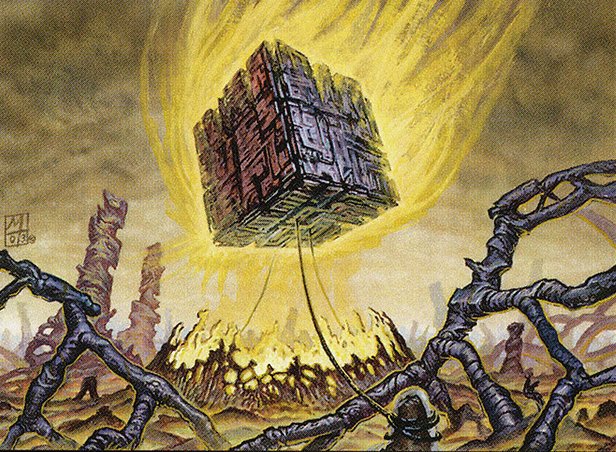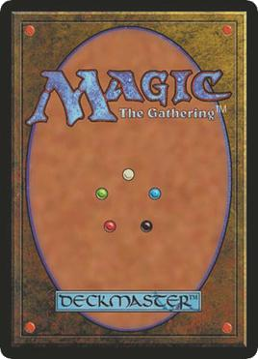 Art by Mark Tedin
Art by Mark TedinHello and welcome to my C/Ube!
This cube is a collection of the most powerful commons and uncommons across Magic's history. Gameplay focuses mostly on strong interaction, fast threats and various forms of recursion. Many of the cards featured here were great playables in their respective draft environments, or are solid constructed staples.
Manafixing is good, with three cycles of ten fixing lands, one cycle of five, and various standalone options, allowing for quite greedy manabases with strong cards in multiple colours. However, most of this fixing is quite slow, often entering tapped. This allows for faster, more focused aggressive decks to capitalize on a stumbling midrange start.
The Magic trifecta of aggro-control-combo is represented, but the focus is mostly on creature-based value or beatdown. There are no hard and fast archetypes, but there are a lot of buildaround cards of varying degrees across all colours. Building a deck with just good cards is viable, but acquiring a powerful engine and building around it is also a sound strategy.
The cube has mostly been drafted in a two-player format. We mostly play winston draft, though we have also done grid draft, burn draft, sealed and traditional draft. Most of our decks tend to have more colours, due to the more limited card pool. However, decks using only one or two colours are perfectly viable.
Rough archetype guideBeing a fairly large cube means that archetypes are supported only roughly. Most of the time a significant part of the cube isn't used in the draft, so the archetypes need to have some overlap as to avoid scenarios where you're left with all enablers and no payoffs, or vice-versa.
I have chosen to write the archetypes down in the form of a rough guide to the three-colour combinations (shards and wedges), though keep in mind that most of the time, each two-colour combination (guild) within a shard or wedge is also capable of playing the same archetype, to an extent.
There's also a lot of monocoloured and multicoloured buildaround cards that could be considered archetypical in their own right, but I think it's more fun to discover those by yourself.
This list is by no means expansive, and most of the cards listed here have applications in other archetypes as well. It is more of a rough guideline as to what to expect when you find yourself in a given colour.
Also a depending factor is how your three-colour deck is structured. A Selesnya deck splashing blue is going to feel slightly different than an Azorius deck splashing green, which is going to feel different to a deck playing all three colours equally.
Without further ado, let's move on to the archetypes!
Bant

 Blink midrange
Blink midrange
Bant decks focus on using powerful enters the battlefield effects, utilizing myriad of ways to reuse these effects, be it through blink or recursion. These decks tend to be on the slower side, but can use a combination of card advantage and evasive threats to establish a strong board presence. The colour combination has the potential to combo, but it rarely happens. Both
 and
and  offer consistency with card selection and ramp, respectively, whilst
offer consistency with card selection and ramp, respectively, whilst  offers strong answers.
Esper
offers strong answers.
Esper 

 Blink tempo
Blink tempo
Esper decks are similar to Bant decks, but they tend to be a bit meaner because of the addition of black. They are usually on the faster side, but they are still midrange decks, lacking the burst damage to close out games fast. They have many effects which hamper the opponents, draw cards, or sometimes both at once. The colours offer some of the best evasive creatures and disruption. They have access to the best removal in the cube due to being in both
 and
and  .
.  offers a suite of strong tempo spells, and the card selection to find what you need.
Grixis
offers a suite of strong tempo spells, and the card selection to find what you need.
Grixis 

 Spells control
Spells control
Grixis decks are usually very mean, and tend to close out games through overwhelming force rather than slow grind. It tends to try and control the board through removal, until it is ready to establish a game-winning threat which closes out the game in short order, either through reanimation or repeated spellslinging.
 and
and  offer myriad spell-based synergies, whilst
offer myriad spell-based synergies, whilst  brings strong disruptive spells.
Jund
brings strong disruptive spells.
Jund 

 Aggressive midrange
Aggressive midrange
Jund decks are usually fairly midrange-oriented, but they tend to be on the faster side of the spectrum. They can use combat tricks, burn, and various death triggers to pose a threat relatively fast. The recursion provided by
 and
and  supplement the aggression brought by
supplement the aggression brought by  , allowing the deck to keep pace with slower midrange, whilst outvaluing aggro decks.
Naya
, allowing the deck to keep pace with slower midrange, whilst outvaluing aggro decks.
Naya 

 Aggro
Aggro
Naya decks are fairly varied, but they are usually very aggressive. They can go wide or go tall, or a combination of both. What they lack in card selection they make up for in raw power. Naya decks can play various themes quite well, be it aggro, combo or midrange. The colours also lend themselves well to various equipment, token or +1/+1 counter-based synergies.
 and
and  have some of the most efficient early game beaters, whilst
have some of the most efficient early game beaters, whilst  brings stability and late-game longevity.
Mardu
brings stability and late-game longevity.
Mardu 

 Sacrifice aggro
Sacrifice aggro
Mardu decks are, like Naya decks, fairly varied. However, most of them are aggressive, and most of them like it when things die. They usually go fairly wide, using either tokens or expendable creatures to build up a board, which they then throw at the opponent with reckless abandon. It is possible to build Mardu lists which eschew attacking in favour of just burning the opponent out, usually through a recursive engine.
 has access to a slew of tokens, and
has access to a slew of tokens, and  and
and  provide ways to generate value from bodies.
Temur
provide ways to generate value from bodies.
Temur 

 Ramp midrange
Ramp midrange
Temur decks usually go pretty big. They have access to great ramp and card selection, whilst also having ways to deal with opposing threats, be it through counterspells and bounce or burn and tricks. Most of your threats can pull double duty in being either a removal spell, or some other form of stabilization. Being in
 , you have great ways to ensure card quality, whilst
, you have great ways to ensure card quality, whilst  and
and  provide some of the biggest monsters in the cube.
Abzan
provide some of the biggest monsters in the cube.
Abzan 

 Sacrifice midrange
Sacrifice midrange
Abzan decks have access to most of the same sacrificial and death-loving cards as Mardu, but where Mardu decks usually trade by attacking, Abzan decks trade by blocking. They slowly build up value, accruing resources and using the graveyard as a second hand. Abzan decks are also the most capable of building combo, having enough efficient creatures to just play a value game if the combo fails.
 cards play well with the graveyard, while both
cards play well with the graveyard, while both  and
and  have their fair share of creatures that don't mind dying, or actively want to die.
Jeskai
have their fair share of creatures that don't mind dying, or actively want to die.
Jeskai 

 Spells value
Spells value
Jeskai decks usually go fairly wide. They don't have to, though. Like Naya decks, they are fairly well equipped to go both ways. The Jeskai deck is also perfectly equipped to play blink, but that is usually not the most popular blink deck. Jeskai decks are not always aggressive, but they usually do feature some spell-based value. In either case,
 usually provides burn, be it to burn faces or creatures.
usually provides burn, be it to burn faces or creatures.  and
and  have various ways to enhance this game plan, be it through more bodies or efficient spells.
Sultai
have various ways to enhance this game plan, be it through more bodies or efficient spells.
Sultai 

 Cycle combo
Cycle combo
Sultai is not so much of a traditional combo deck where you win instantaneously, but more of a deck where you can deploy a massive threat with relative speed, whilst also having great disruption at your disposal. The colours allow you to grind relatively well, and a lot of their cards have multiple uses. This, combined with great recursion, allow you to have answers and threats at multiple stages of the game. The deck is sometimes on the slower side, and sometimes prone to being disrupted. However, the colours give enough opportunities for a second chance.
 has the fattest creatures in the cube,
has the fattest creatures in the cube,  and
and  have ways to put them in the graveyard and take them out, whilst also providing removal and card quality.
Banned cards
have ways to put them in the graveyard and take them out, whilst also providing removal and card quality.
Banned cards
The cube has a couple of notable omissions and banned cards, due to various reasons.
Sol Ring is banned and has been banned forever for obvious reasons. The card leads to many non-games in which the t1 Ring allows for busted sequences.
Skullclamp is also banned for obvious reasons. It plays very very well in each and every deck, and drawing it will almost guarantee a win. It was in the cube for a short bit, but was quickly taken out.
Orzhov Advokist was a very strong card. It could often provide an insurmountable amount of value fairly consistently. It was also relatively easy to recur.
Ghostly Prison was removed mostly because it was just a very good check to aggro decks, whilst not helping much against midrange or other control decks.
Timely Reinforcements see Ghostly Prison.
Mana Drain has never been in the cube, and never will be, because I feel that it leads to silly sequences, which I don't think is particularly healthy for the cube environment.
Sphinx's Tutelage used to be in the cube, and was one of the go-to non-interactive win conditions. It lead to feel bad situations where you either didn't draw your Tutelage in time, or you drew it in your opening hand and your opponent couldn't remove it.
Propaganda see Ghostly Prison.
Laboratory Maniac was in the same situation as Sphinx's Tutelage, but was one of the few cards that won the game without being played. It often came down to a last turn in which all interaction pieces were put on the table, and the Maniac player either won or didn't.
Hymn to Tourach is banned because it lead to some very feel-bad scenarios where both lands in an opening hand were discarded, which wasn't very fun gameplay.
Curse of Disturbance is banned. I do run its weaker sibling Curse of Shallow Graves, but because I try to keep duplicates to a minimum I've cut the stronger one of the pair.
Constant Mists, like many other cards on this list, lead to fairly non-interactive gameplay.
Arachnogenesis did the same thing as Constant Mists, but with even more feel bad attached. It could often just wipe the board for 
 .
.
Overrun on the other end of the spectrum, Overrun ended its fair share of games, but just as many times rotted in hand.
Ashiok, Dream Render randomly hosed graveyard decks and ramp decks super hard, which wasn't very fun. Was also surprisingly difficult to interact with, often.
Behemoth Sledge is like Loxodon Warhammer, but immediately forces you to be in both green and white. The extra toughness also often made sure the creature stuck around longer.
Loxodon Warhammer has been banned again. It has proven to be a nuisance when you're unable to get rid of it, and leads to unfun play patterns for both players.
Consistently attacking with 3 is more difficult than it seems.

